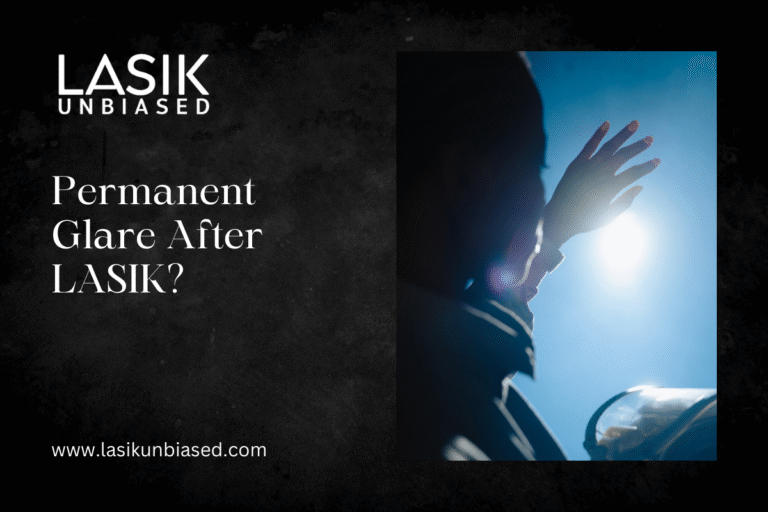Yes, some patients may experience glare permanently after LASIK, but this is rare.
When managed by a skilled surgeon and paired with proper patient selection, LASIK has a high success rate and minimal long-term side effects.
This blog will provide an in-depth look at the potential causes of prolonged glare after LASIK, the factors that contribute to this phenomenon, and what you can do if you face such issues. Whether you’re researching LASIK or have undergone the procedure, this guide breaks everything down clearly and concisely.
Understanding LASIK Surgery
LASIK (Laser-Assisted in Situ Keratomileusis) is a revolutionary procedure that reshaped how we treat refractive vision errors like myopia, hyperopia, and astigmatism. A commonly performed and minimally invasive surgery, LASIK uses advanced laser technology to reshape the cornea, improving how light enters the eye and is focused onto the retina.
While safe and effective for most individuals, some patients experience temporary, and in rare cases, persistent visual side effects like glare, halos, or starbursts.
What Exactly Is Glare After LASIK?
Glare refers to an increased sensitivity to bright light, often accompanied by a “halo” or “starburst” effect around light sources, particularly at night. This can make activities like night driving challenging, as headlights or streetlights seem excessively bright.
Glare is relatively common during the healing process following LASIK. However, if the issue persists beyond six months, it may be a sign of an underlying complication.
Causes of Permanent Glare After LASIK
Several factors can lead to glare that persists long after LASIK surgery. Below are the primary causes:
1. Irregular Corneal Healing
After LASIK, the cornea goes through a natural healing process. The surgery involves reshaping the cornea’s curvature, and in some cases, irregular healing patterns can occur. This unevenness may permanently affect how light is refracted, leading to glare.
For example:
- Uneven corneal surfaces scatter light irregularly.
- Scars or tissue disruptions from improper healing may impact visual clarity.
2. Pupil Size vs. Laser Zone
Patients with large pupils can be more prone to glare, especially when the diameter of their pupil exceeds the treated area on the cornea in dim lighting conditions. Light entering the untreated peripheral area of the cornea during night-time vision creates the perception of glare.
This issue has reduced significantly thanks to advancements in LASIK technology, whereby custom wavefront-guided treatments cover larger optical zones.
3. Pre-existing Conditions
Certain underlying eye conditions may exacerbate glare after LASIK. These include:
- Dry Eye Syndrome: Persistent dryness post-LASIK can disrupt the corneal surface, increasing the scatter of light.
- Keratoconus (irregular thinning of the cornea): If improperly diagnosed pre-surgery, this condition could worsen after LASIK, contributing to glare.
- High Refractive Error: Patients with severe myopia or hyperopia are more likely to encounter post-surgical glare due to the level of adjustment made to the cornea.
4. Older LASIK Techniques
Today’s LASIK technologies incorporate highly precise and individualised corrections. But patients treated many years ago using older techniques may experience sustained issues like glare due to limitations in past laser systems.
5. Postoperative Complications
Although rare, some postoperative complications could influence visual clarity:
- Flap Wrinkles (Microstriae): If the corneal flap created during LASIK folds or wrinkles during healing, it can disrupt light refraction.
- Overcorrection or Undercorrection: Imperfect surgical outcomes, where the correction needed was not fully achieved, might lead to visual disturbances, including glare.
How Often Does Permanent Glare Occur?
The good news is that permanent glare after LASIK is far from common, thanks to significant advancements in technology and surgical methods. Studies show that the vast majority of LASIK patients experience short-term visual symptoms that resolve within 3 to 6 months.
For instance:
- A clinical study published on LASIK outcomes reported that 98% of participants were satisfied with their results, with only a small fraction experiencing long-term glare.
- Wavefront-guided LASIK procedures have significantly reduced the incidence of glare and halos, with some studies reporting rates below 0.5% in carefully selected patients.
Managing and Treating Permanent Glare
If you’ve undergone LASIK and are struggling with ongoing glare issues, there are several potential solutions to explore:
1. Customised Contact Lenses
Specialised contact lenses, such as scleral lenses or rigid gas-permeable lenses, can help reshape the light entering the cornea and reduce glare.
2. Enhancement Surgery
For patients with undercorrection or overcorrection as the cause of their glare, enhancement surgeries may help refine and improve outcomes. Wavefront-guided techniques can address irregularities that contribute to glare.
3. Corneal Collagen Cross-Linking (CXL)
If keratoconus or corneal instability is a contributing factor, procedures like corneal collagen cross-linking could stabilise the cornea and improve symptoms. This is often suggested as a secondary solution after LASIK.
4. Treating Dry Eye Syndrome
Chronic dry eye is a common culprit behind postoperative visual issues. Solutions include:
- Artificial tears
- Prescription drops like Restasis
- Punctal plugs to conserve natural tears
5. Anti-reflective Lens Coatings
Glasses or lenses with anti-reflective coatings can reduce glare caused by bright light, particularly in low-light environments like night driving.
6. Medication or Physical Therapy Alternatives
Photophobia or extreme light sensitivity related to glare may be alleviated through visual therapy or photophobic-specific treatments like tinted eyewear. Sometimes, these treatments work alongside surgical corrections.
Reducing the Risk of Glare Before LASIK
Prevention often begins with careful preoperative assessments and choosing the right medical experts. Here are steps you can take:
- Choose a Reputable and Experienced LASIK Surgeon
Ensure the surgeon uses advanced technologies like wavefront-guided LASIK.
- Assess Candidacy Thoroughly
Patients with large pupils, dry eyes, or high prescriptions should discuss risks in depth with their surgeon.
- Follow Post-op Care Guidelines
Proper care following LASIK (e.g., using prescribed eye drops) reduces the chances of complications.
LASIK and Life with Better Vision
While glare after LASIK might sound daunting, keep in mind that the overwhelming majority of patients achieve life-changing improvements in visual clarity without long-term visual disturbances. Today’s advanced LASIK technologies have significantly minimised risks, making complications like permanent glare rare.
If glare persists after LASIK, consult your surgeon immediately to explore tailored solutions. Further advancements in eye care make it increasingly possible to address even the most stubborn symptoms.


